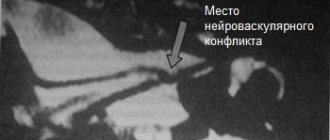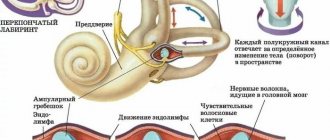1. How does dizziness manifest in osteochondrosis?
2. How are dizziness and cervical osteochondrosis related?
2.1 The main causes of the development of osteochondrosis
2.2 The main causes of dizziness in osteochondrosis
3. Clinical picture
4. Diagnostics
5. How to treat?
6. Prevention
Without a doubt, one of the most common symptoms is dizziness. This symptom occupies a leading place in prevalence and is associated with a number of pathological conditions and diseases, which indicates its nonspecificity; however, there are some types of dizziness that occur only in certain conditions, for example, cervicogenic dizziness with pathology of the cervical spine. A symptom such as dizziness can occur with a wide range of neurological, vascular and mental diseases and require a mandatory diagnostic and therapeutic approach, as it is often a symptom of a serious and even life-threatening disease.
The appearance of systematic dizziness occurs in more than 35% of people living in large populated areas. Very often, dizziness accompanies neurological and vascular diseases and can be a harbinger of the development of transient or acute cerebrovascular accident. In more than half of the cases, the occurrence of constant sluggish dizziness is formed against the background of diseases of the musculoskeletal system.
How does dizziness manifest in osteochondrosis?
Dizziness, or synonymous with vertigo, is a pathological feeling of uncertainty in assessing the position of one’s body in space, while the sick person feels as if the objects surrounding him are rotating around him, less often the sensations are of the opposite nature, i.e. the feeling of rotating your own body around surrounding objects. These sensations lead to uncertainty in one’s actions, disrupt motor skills and cause awkwardness in the patient’s movements. With fairly severe manifestations of dizziness, in addition to the main symptom - uncertainty in movements, neurological symptoms are added in the form of nausea and even vomiting with severe dizziness. The patient also experiences some autonomic disorders, such as:
- Increased heart rate and pulse;
- Unstable blood pressure;
- Increased sweating, especially of the upper extremities and face;
As dizziness increases, all of the above accompanying symptoms also progress proportionally and become more pronounced.
In neurological practice, it is very convenient to divide dizziness into several main types, depending on the pathogenetic mechanism of its formation. The following types of vertigo are distinguished:
- Systemic dizziness. Such dizziness has a vestibular cause and occurs when moving the head. The patient feels dizziness in the form of falling or continued rotation in response to head movement. Very often, systemic dizziness is complemented by severe hearing problems.
- Syncope or presyncope. Dizziness is a common symptom and warning sign of impending loss of consciousness. Dizziness occurs and increases along with a general deterioration in clarity of consciousness. The person becomes unstable, loses balance, and notices cloudiness or darkening in the eyes. If this condition occurs, the victim may fall and cause serious injury to himself.
- Neuralgic cerebrogenic dizziness. It occurs as a result of organic pathology with localization in the parts of the brain responsible for balance. For example, when the cerebellum is damaged in a person suffering from a stroke or traumatic brain injury, cerebellar ataxia occurs, one of the manifestations of which is constant dizziness. In other cases, cerebrogenic imbalance occurs due to paresis or paralysis, but in this case the feeling of dizziness is false.
- Cervicogenic dizziness. Such dizziness occurs with pathology of the cervical spine, most often with osteochondrosis. The formation of a feeling of awkward body position in space occurs as a result of a violation of proprioceptive sensitivity in the peripheral nervous system. It is the occurrence of dizziness of a cerebrogenic nature that is most often observed in patients.
About cervical vertigo
About the article
46656
0
Regular issues of "RMZh" No. 10 dated May 29, 2004 p. 578
Category: Neurology
Authors: Gorbacheva F.E. , Matveeva L.A. , Chuchin M.Yu.
For quotation:
Gorbacheva F.E., Matveeva L.A., Chuchin M.Yu. About cervical dizziness. RMJ. 2004;10:578.
It is well known that dizziness is a very common complaint among patients of various age groups. Most often it bothers elderly and mature people, but it also occurs among young people, adolescents and children. There are many causes of dizziness, from serious to easily treatable. First of all, it is necessary to clarify what the patient means by the sensation experienced, interpreted as dizziness. Dizziness is often referred to as a disorder of balance and instability, in other cases it refers to a pre-fainting state. True (vestibular, systemic) dizziness is a sensation of imaginary movement of surrounding objects or one’s own body, i.e. illusion of non-existent movement, rotation, “falling through” of the patient or the environment. Systemic vertigo is caused as a result of dysfunction of different parts of the vestibular system - both its peripheral part (semicircular canals, vestibular nerve) and central parts (vestibular nuclei of the brainstem, parietotemporal parts of the cerebral cortex). The vestibular system performs the complex function of maintaining body balance when performing various voluntary and involuntary movements (kinetic loads) and maintaining and changing posture (postural loads). This function is successfully carried out by the vestibular system due to its numerous connections with other parts of the neural system - visual, proprioceptive, cerebellar, extrapyramidal, cortical and spinal. When performing the balance function, the initial impulse comes from the peripheral receptors of the semicircular canals of the labyrinth, from there, through the vestibular nuclei of the brain stem (in particular, the lateral vestibular nuclei), due to their numerous connections with other systems, complex mechanisms for creating balance are activated at each specific moment of the movement - walking, running, changing direction and pace of movement. Of decisive importance is the transmission of impulses from the lateral vestibular nuclei (LVN) to the motor spinal structures through the vestibulo- and reticulospinal tracts, which correct the tonic tension of skeletal muscles, reducing the tone in some muscle groups and increasing it in others, creating a stable equilibrium position.
Damage to the vestibular apparatus leads to three characteristic symptoms - dizziness, nystagmus and impaired coordination of movement (ataxia).
Automatic and conscious spatial orientation suffers - the patient creates a false sensation of displacement of his own body and surrounding objects - the illusion of rotation, movement.
Damage to the vestibular apparatus is accompanied by a disruption of normal reciprocal muscle tone. Movements are deprived of normal regulatory influences and their incoordination occurs - vestibular ataxia, an unsteady gait appears, and falls may occur. A certain place among the systems involved in maintaining balance is occupied by the system of proprioceptive sensitivity.
The greatest flow of impulses to the PVN comes from the structures of the neck - bone-ligamentous, joint and muscle receptors, which increases even more with pathological changes in the neck, in particular, the cervical spine (with osteochondrosis, spondylosis, etc.) Dizziness provoked by movements in the neck has long been attracted attention and was called “cervical vertigo.”
(Dix, 1989). Over the years, various researchers have tried in one way or another to explain the occurrence of dizziness in cervical pathology, but the proposed aspects of the pathogenetic mechanisms remained hypothetical. It was believed that vestibular symptoms in cervical spondylopathies arise from irritation of the cervical sympathetic plexus, resulting in insufficient blood supply to the labyrinth. Another opinion suggested increased excitability and increased proprioceptive impulses from the cervical structures as a result of degenerative changes in the osseous-ligamentous apparatus. It was assumed that these disturbances in somatosensory input cause disturbances in spatial orientation, vertigo and nystagmus, especially during movements of the head and neck (De Yong, 1967). However, many supported the vascular theory of the occurrence of disorders caused by transient ischemia of the labyrinth as a result of compression of the vertebral artery or periarterial sympathetic plexus in the bone canal. Gradually, the concept of vertebrobasilar insufficiency (VBI) replaced the previously existing theory of vascular spasm, and the appearance of dizziness and/or instability began to be explained from this position. Among diseases of the cervical spine, the most common are degenerative processes:
osteochondrosis and spondyloarthrosis.
Under the influence of mechanical loads, changes occur not only in the intervertebral discs, but also reactive changes in the adjacent vertebral bodies, their ligamentous apparatus and muscles. Growing osteophytes have different directions and localizations. These manifestations of spondylosis are found both on the anterior surface of the vertebral bodies and on the posterior, and are directed towards the spinal canal and the canal of the vertebral artery. The latter is easily injured with uncovertebral arthrosis. Traumatization of the spinal roots and their membranes causes pain in the cervical-occipital region and shoulder girdle, pain in the arms, and numbness in them. The above disorders occur after prolonged forced positioning of the head and neck, as well as after sleep. Often there is a persistent limitation of neck mobility in one or several directions due to reflexively tense neck muscles. Thus, in cervical osteochondrosis, the leading clinical syndrome is pain, and the source of pain impulses is the receptors of the fibrous ring of the disc, ligamentous apparatus, joint capsule, and tense muscles. If osteophytes develop in the bony canal of the transverse processes of the cervical vertebrae, then irritation of the periarterial sympathetic plexus around the vertebral artery can be expected when bending or turning the head. In this situation, it is possible to develop dizziness, headaches and visual disturbances - i.e. posterior cervical sympathetic syndrome. Dizziness caused by cervical spondylosis can develop when the vertebral artery is compressed during manipulation of the neck. However, in addition to dizziness, other symptoms are observed due to ischemia of the brainstem-cerebellar structures, such as: diplopia, dysarthria, cerebellar disorders. Rare causes of attacks of dizziness and balance disorders are congenital anomalies of the cervical spine and posterior cranial fossa.
Their clinical debut often occurs in childhood and adolescence, less often in young and adulthood.
In type 1 Arnold-Chiari malformation, the mentioned attacks of systemic dizziness are often isolated complaints of patients. At the same time, in patients with degenerative-dystrophic changes in the cervical spine, when suddenly turning the head, “pushes to the side” and instability are often observed, which can lead to a fall. In this case, the patient experiences an inexplicable feeling of spatial disorientation, which he interprets as “dizziness,” but without a clear sense of the imaginary movement of the surrounding. The basis of this “cervical vertigo” is (mainly) imbalance and vestibular ataxia. Currently, there is a widespread belief about the leading role of cervical osteochondrosis and vertebrobasilar insufficiency in the development of attacks of dizziness or instability in elderly and mature people. Nevertheless, the hypothetical nature of this situation continues to persist. positional vertigo
) is unreasonably often explained by pathology of the cervical spine (“cervical vertigo”) .
The clinical picture of DPG is clearly defined and the causes of its occurrence are clarified. DPG occurs when position changes, i.e. movement of the head and neck. This is paroxysmal dizziness that develops when throwing the head back, bending down; the attack of dizziness is strong, but short-lived - within a few seconds; when the position of the head that caused the attack changes, it disappears. The causes of DPG are deposits of calcium carbonate crystals that appear with age, sometimes after trauma, in the semicircular canals of the labyrinth (so-called cupulolithiasis); when the position of the head changes, they irritate the receptor apparatus of the labyrinth, as a result of which an attack of dizziness occurs. The condition is diagnosed using fairly simple Dix-Hallpike tests. Attacks of systemic vertigo that occur in people over 45 years of age, accompanied by nausea and vomiting, horizontal or horizontal-rotatory nystagmus (Menière-like), are also often explained by “cervical vertigo” as a result of osteochondrosis or VBI. Currently, using electrocochleography, it has been established that in a significant proportion of cases they are caused by hydrops of the labyrinth, which, in contrast to idiopathic hydrops in Meniere's disease, is called secondary, i.e. developing against the background of various, often somatic, pathologies. Thus, in our opinion, “cervical dizziness” can only be attributed to those cases when, in persons with severe osteochondrosis or other pathology of the cervical spinal segment, when turning the head, there is an imbalance and even a fall (which patients usually explain by dizziness, although it is not one). The mechanisms of these balance disorders can be explained by Magnus stem reflexes, which occur with the participation of vestibuloreticular structures of the brain stem. A powerful flow of afferent impulses from the proprioceptors of the neck is directed to the LVN, as a result of which there is a sharp increase in muscle tone in the ipsilateral muscles of the trunk and limbs and a decrease in the contralateral muscles, resulting in an imbalance. Since the starting point of impulses to the muscles of the trunk and limbs are the PVN, it is advisable to influence their receptor apparatus in order to reduce the efferentation that causes balance disorders. The histaminergic system plays an important role in the functioning of the vestibular structures (in particular, the LVN). Therefore, if there is an imbalance, as is observed with “cervical dizziness,” the use of antihistamines is justified. , betahistine hydrochloride (Betaserc)
, has been used with the greatest therapeutic effectiveness .
The drug blocks H3 and stimulates H1-histamine receptors. By blocking H3 receptors, Betaserc increases the release of neurotransmitters from the nerve endings of the presynaptic membrane (which is prevented by histamine), thereby exerting an inhibitory effect on the vestibular nuclei of the brain stem. Betaserc has proven itself positively in Meniere's disease and other causes of vestibular dysfunction. Studies conducted to evaluate the effectiveness of the drug, including double-blind studies, indicate the high effectiveness of betahistine dihydrochloride in this disease. At the time of an attack, taking 2-3 Betaserc tablets helps relieve dizziness. For Meniere's disease, Betaserc can be prescribed for a long time, as it is not addictive, does not have a toxic effect on the body, does not have a sedative effect, and does not affect blood pressure and heart rate. Long-term use of Betaserc can stop the progression of the process. In addition, if you have Meniere's disease, it is recommended to limit your coffee intake and stop smoking. The drug reduces the frequency of attacks of systemic dizziness and reduces balance disorders. The great advantage of Betaserc is the fact that it can be taken for a long time, since it has no toxic effect on the body, does not cause a sedative effect, does not affect blood pressure and heart rate, and what is especially important is that it is not addictive. The daily dose of the drug for adults is 48 mg in 3 divided doses. The tablet contains 16 mg of betahistine dihydrochloride. Literature
1. Diseases of the nervous system. Ed.N.N.Yakhno, D.R.Shtulman, ed. 2. M. Medicine, 2001 2. Dizziness. Ed.M.R.Dix, J.D.Hood.M, Medicine, 1989 3. Afanasyeva S.A., Gorbacheva F.E. Isolated systemic dizziness. Neurological Journal. v.8, no. 4, 2003, 36–40 4. Barre JA Sur un syndrome Sympathique cervical posterieur et sa case frequente: l'arthrite cervicale. Revue de Neurologie. 1926, 45, 1246–1253 5. Fisher FE Vertigo in cerebrovascular disease. Arch. of Otolaryngology, 1967, 85, 529–534 6. Barany R. Diagnose von Krankheitserscheinungen im Bereich des Otolithenapparates. Acta Otolaryng. 1921, 2, 434–437 7. Dix MR, Hallpike CS The Pathology, Symptomatology and Diagnosis of Certain Common Disorders of the Vestibular System. Ann. of Otology, 1952, 61, 987–1016 8. Brandt T. Vertigo. Its Multisensory Syndromes. 2nd ed. Springer, London, 2000. p.441–451
Content is licensed under a Creative Commons Attribution 4.0 International License.
Share the article on social networks
Recommend the article to your colleagues
How are dizziness and cervical osteochondrosis related?
Osteochondrosis is one of the most common and frequent causes of dizziness. With this disease, damage occurs to the cartilage tissue of the intervertebral discs of the cervical spinal column as a result of a violation of their nutrition or trophism. As a result of disturbed metabolism, dystrophic processes are formed in cartilage tissue, which leads to a decrease in the volume of cartilage and its destruction, as a result of which the spinal column loses a significant degree of its shock-absorbing properties. The load on the bodies of the cervical vertebrae increases, which leads to their mechanical trauma and subsequent destruction. Bone growths or spines appear on the vertebrae, the mobility and mobility of the vertebrae is significantly reduced, and their height also decreases, which leads to the gradual involvement of spinal cord neurons and their processes in the inflammatory process, which exit through the lateral openings between the vertebrae in the form of sensory and motor nerve fibers as part of nerve roots. In the absence of timely diagnosis and treatment, osteochondrosis progresses and leads to the development of serious complications in the form of organic damage to nervous tissue, one of the symptoms of which is the development of cervicogenic dizziness.
The main causes of the development of osteochondrosis
Osteochondrosis is a multifactorial disease and it is not possible to identify any specific factor leading to its occurrence. However, among a wide range of pathogenic factors, several leading factors can be identified, which include:
- Hereditary genetic predisposition;
- Systematic long-term physical inactivity or, conversely, increased load on the musculoskeletal system;
- Dysmetabolic disorders;
- History of chronic infectious diseases.
All of the above factors can lead to the development of osteochondrosis, both individually and in combination. When exposed to two or more factors from the above list, the risk of gradual formation of osteochondrosis increases significantly.
The main causes of dizziness in osteochondrosis
Whether dizziness can occur with cervical osteochondrosis is a complex question. Of course, in most clinical cases this symptom is present, but there are also situations when osteochondrosis progresses in a latent form without dizziness and other vegetative manifestations. It is important to immediately note that only osteochondrosis of the cervical spine is accompanied by the appearance of the symptom of dizziness. As mentioned above, osteochondrosis leads to a decrease in the area and volume of the intervertebral discs, which leads to its flattening and compression or compression of the spinal nerve endings, while in addition to the direct effect on the nervous tissue, compression of the vertebral or vertebral arteries occurs, which entails a chronic impairment of oxygenation nervous tissue of the spinal cord and medulla oblongata. The complex effect of chronic ischemia and trauma to nerve fibers leads to increased sensitivity and irritation of autonomic nerve endings, resulting in cervical dizziness.
Treatment of cervical osteochondrosis
Patients are shown treatment aimed at eliminating pain, neurological disorders, normalizing muscle tone, improving blood circulation and stopping the progression of degenerative changes in the intervertebral discs. To be as effective as possible, it must be comprehensive.
In the acute period, patients are advised to rest. If necessary, wearing an orthopedic bandage – Shants collar – is prescribed.
Treatment tactics are selected individually for each patient depending on the degree of osteochondrosis, the presence of vertebral artery syndrome, neurological deficit and other disorders. There is no single, universal treatment regimen, since the doctor needs to take into account many disparate factors, in particular the presence of other concomitant diseases, the patient’s age, etc.
As a rule, patients are prescribed:
- drug therapy;
- physiotherapy;
- exercise therapy;
- manual therapy.
Also, patients diagnosed with osteochondrosis or spondylosis are advised to increase the level of physical activity, this is especially true for representatives of “sedentary” professions and people in general leading a sedentary lifestyle. So, if you need to do work while sitting in a forced position, it is recommended to take breaks every hour for active warm-up.
Drug therapy
Drug therapy for osteochondrosis and related disorders is aimed at improving well-being and eliminating existing pathological changes. Therefore, it is complex in nature and may include individually selected drugs from the following groups:
- NSAIDs are drugs with analgesic and anti-inflammatory properties, available in a variety of dosage forms. With their help, you can relieve pain of mild and moderate intensity, as well as reduce the inflammatory process. But when choosing forms for oral use (tablets, capsules), you need to be careful, since most drugs in this group have a negative effect on the functioning of the gastrointestinal tract and can provoke an exacerbation of peptic ulcers and gastritis. In most cases, NSAIDs are prescribed in short courses and then used on demand, that is, when pain occurs.
- Corticosteroids are medications prescribed to patients with advanced inflammatory processes that cannot be eliminated with NSAIDs. These drugs are prescribed only in short courses. They are also used to relieve severe pain when performing cervical spine blocks.
- Muscle relaxants are drugs used in the presence of severe muscle spasms. Thanks to them, it is also possible to reduce pain.
- Chondroprotectors are medications used to activate the regeneration processes of intervertebral discs. Most of them contain substances normally used by organisms to restore cartilage tissue, and therefore are completely safe. They are prescribed in long courses, lasting at least several months.
- B vitamins are drugs prescribed to improve nerve conduction, which is important in the presence of neurological disorders.
- Vascular drugs are drugs selected depending on the nature of the existing pathological changes. They improve the quality of blood circulation and thereby reduce the likelihood of dizziness, as well as dangerous complications of vertebral artery syndrome.
- Nootropics are drugs prescribed to improve brain function and prevent changes in it.
To relieve attacks of dizziness in osteochondrosis, as well as reduce the manifestations of balance disorders, patients can be prescribed betahistine hydrochloride (Betaserc). This drug is classified as a vestibulolytic drug. It helps improve blood supply to the structures of the inner ear, including the labyrinth, activates blood flow in the vertebrobasilar region and improves the condition of the vestibular structures of the brainstem and cerebellum. At the same time, he has proven himself exclusively on the positive side. It has no toxic effect on the body, is not addictive and effectively eliminates dizziness. Depending on the specifics of the situation, Betaserc can also be prescribed in long courses of 2-3 months in order to stop the progression of the pathological process.
Physiotherapy
For osteochondrosis, physiotherapeutic procedures are often prescribed to increase the effectiveness of other treatment methods. They help relieve inflammation, reduce pain, activate blood flow and normalize muscle tone. In most cases, they resort to help:
- electrophoresis;
- ultrasound therapy;
- magnetic therapy;
- laser therapy;
- diadynamic currents.
Depending on the severity of the situation, patients are prescribed a course of 7-15 procedures performed at certain intervals.
Exercise therapy
Regular, daily physical therapy exercises are recommended for all patients diagnosed with osteochondrosis. They allow:
- strengthen the muscles of the neck and shoulder girdle, which will reduce the load on the intervertebral discs and help stop the further progression of osteochondrosis;
- eliminate muscle spasms, thereby reducing pain, as well as the risk of compression of the vertebral artery by overly toned muscle;
- activate blood circulation, which will not only have a positive effect on the functioning of the entire vestibular system, but will also help to activate the nutrition of the intervertebral discs, which will also prevent the worsening of osteochondrosis.
But the training program must be compiled strictly individually, taking into account the changes detected using instrumental diagnostic methods. Otherwise, exercise can provoke not only a deterioration in well-being, the appearance of new attacks of dizziness, but also the progression of existing disorders. Therefore, the exercise therapy program should be drawn up by a specialist who has the results of the patient’s examination.
It is recommended to conduct the first classes under the supervision of a physical therapy instructor. This is required so that the patient can master the correct technique for performing each exercise shown to him, which will increase their effectiveness.
To obtain a therapeutic effect, it is important that exercise therapy be carried out systematically. Therefore, it is necessary to make time for them in your daily routine. In this case, the exercises should in no case be accompanied by sudden movements, as this can lead to compression of the vertebral artery, compression of the nerve and the development of an attack of acute dizziness, including loss of consciousness. Also, such carelessness can provoke a sharp increase in pain and a general deterioration of the condition. Therefore, it is necessary to engage in physical therapy in a calm, comfortable environment, without haste, making all movements confidently but smoothly.
In case of osteochondrosis, swimming has a very positive effect on the condition of the intervertebral discs, since this type of physical activity has a positive effect on the functioning of the whole body, but is not associated with an increased load on the cervical vertebrae. Therefore, almost all patients are recommended to visit the pool.
Manual therapy
In the treatment of osteochondrosis, one of the most effective methods is manual therapy. Thanks to her, she manages to:
- increase the distance between the vertebral bodies, thereby reducing the load on the intervertebral discs and preventing their further degeneration;
- eliminate compression of nerves;
- normalize muscle tone;
- eliminate pressure on the vertebral arteries, which will improve blood flow;
- eliminate pain, neurological disorders, attacks of dizziness;
- increase neck mobility.
However, working with the cervical spine requires a high level of qualification from a specialist. Indeed, unlike therapeutic massage, manual therapy involves deep work not only of muscles, but also of ligaments, as well as a direct effect on the vertebrae. Considering the relative fragility of the cervical spine, work with it should be carried out carefully and with a deep understanding of the techniques and features of the impact. Otherwise, there is a risk of worsening the condition and developing complications. At the Institute of Human Restoration, manual therapy is carried out by the best specialists who thoroughly understand the intricacies of working with the cervical spine and know the most effective methods for treating osteochondrosis in Moscow.
You can begin manual therapy only after the acute inflammatory process has stopped. Patients are prescribed a course of procedures, the number and frequency of which is determined individually. As a rule, patients notice significant positive changes after the first session. But it is important not to interrupt treatment and complete the entire course to the end. This will allow you to get the most pronounced, and most importantly, lasting result.
Thus, dizziness with osteochondrosis is not uncommon. It can occur as a result of the development of a variety of pathological changes caused by degenerative processes in the intervertebral discs, which affects the nature of the attacks and also determines the characteristics of the accompanying symptoms. But in any case, the appearance of dizziness should be considered as a reason for promptly contacting a neurologist. Otherwise, there is a risk of complications, including stroke as a result of acute cerebrovascular accident. Specialists from the Institute of Human Restoration are always ready to help, conduct comprehensive diagnostics and treatment of osteochondrosis and related pathologies.
0 0 votes
Article rating
Clinical picture
The symptoms of dizziness in osteochondrosis are specific. As a rule, awkwardness and impairment of motor activity are of minor intensity. The feeling of imbalance is stable and gradually increases as osteochondrosis of the cervical spine progresses. As mentioned above, dizziness is often accompanied by other neurological symptoms, such as headache, nausea and vomiting, hyperhidrosis or increased sweating, weakness and increased heart rate.
In some cases, patients may experience attacks of dizziness with cervical osteochondrosis.
Diagnostics
If dizziness appears, especially if the symptom increases, you should not sit idly by. Only a consultation with a qualified specialist and a full diagnostic study will help to conduct a differential diagnostic search and identify a specific pathology. At the Clinical Institute of the Brain there is an entire department dedicated to the treatment of osteochondrosis of the cervical spine and related complications. An integrated approach to diagnosis allows you to accurately assess the severity of neurological disorders and the localization of the pathological inflammatory process. The following diagnostic methods are used at the Clinical Brain Institute:
- Computed tomographic or magnetic resonance imaging study, which allows a detailed assessment of the localization and degree of the inflammatory process in the intervertebral discs and vertebrae.
- X-ray of the cervical spine;
- Ultrasound Doppler mapping of neck vessels;
- Comprehensive analysis of the patient’s vestibular function.
Causes of dizziness
Dizziness itself is caused by decreased blood flow to the brain. Oxygen starvation of the brain occurs, since the vertebral arteries are compressed during osteochondrosis. However, there may be other causes of headaches that you should not tolerate and try to get rid of them on your own without consulting a doctor:
- Sharp spasm of the neck muscles
- Vertebral artery syndrome
- Low mobility of the spine due to an inactive lifestyle
- Psychological factor – frequent worries due to the presence of the disease
How to treat?
I feel dizzy with cervical osteochondrosis, what should I do? First of all, you should consult a specialist for advice. Only after the examination can we talk about drawing up an effective treatment plan. Treatment of dizziness with osteochondrosis of the cervical spine consists of complex therapy using both medications and physical procedures. For the purposes of pharmacotherapy, the following groups of drugs are used:
- Non-steroidal anti-inflammatory drugs. They can significantly reduce the amount of inflammation, relieve swelling and, accordingly, compression of the nerve roots and spinal cord. For a more effective effect at the time of therapy, a course of injectable forms of anti-inflammatory drugs is used. The main drugs in this group include: Diclofenac, Ibuprofen, Nurofen and Meloxicam.
- Cerebroprotectors and nootropics are drugs that improve cerebral circulation and metabolic processes in nervous tissue. These drugs include: Piracetam, Cinnarizine, Cavinton or Vinpocetine.
- Chondroprotojectors are means that protect cartilage tissue from destruction. This group of drugs improves the elastic and shock-absorbing properties of the cartilage tissue of the intervertebral disc, thereby relieving compression syndrome.
It is important to note once again that treatment must be comprehensive and complex; only in this case can one hope for a good effect from therapy. For this purpose, in addition to medications, physiotherapy is also used: therapeutic electrophoresis on the neck area, ultrasound and magnetic therapy. The systematic implementation of therapeutic exercises also plays a significant role.
Prevention
In order to prevent the development or progression of osteochondrosis of the cervical spine and associated dizziness, as well as other neurological manifestations, the same complex of physiotherapeutic methods is used. To avoid the development of this disease, it is important to understand that only the absence of pathogenic factors can eliminate the unnecessary risk of developing osteochondrosis and its complications. To do this, you need to change your lifestyle and attitude towards your own health. Such simple things as an active lifestyle, proper nutrition, alternating work and rest significantly reduce the risk of osteochondrosis and its manifestations. Take good care of your body and be healthy.
Clinical Brain Institute Rating: 4/5 — 127 votes
Share article on social networks










